 Loading... Please wait...
Loading... Please wait...-
CALL US ON +37068528146
- My Account
- Gift Certificates
- Items / $0.00
All prices are in All prices are in USD
Categories
- Home
- Baltic Value Blog
- cepelinai
Baltic Value Blog - cepelinai
Glossary of Lithuanian Food
Posted by Baltic Value with a support of Aldona Sikora. Collected from online available sources. on 12th Oct 2014
Please send us your inputs at: info@balticvalue.com
| Alus - beer. Lithuania has quite a few award-winning brewery brands (Švyturys, Utenos Alus, Kalnapilis, Volfas Engelman). The Northern part of Lithuania is also famous for its boutique famous for its boutique micro-breweries. |  |
| Balandėliai – stuffed cabbage rolls. literally translated as "little pigeons". Balandėliai is ground meat filling wrapped in cabbage leaves. It is a well known and liked dish in Lithuanian cooking. |  |
| Balta mišrainė - "white salad". Likely the most known salad in Lithuania. It is made from potatoes, carrots, peas, eggs and mayonnaise. See also Raudona mišrainė. |  |
| Bandelės - buns. A variety of buns are baked at homes and in bakeries, the most popular being with cinnamon, poppy seed, curd cheese, jam fillings. Also see Lasineciai. | 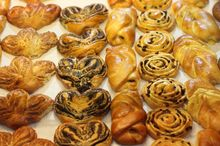 |
| Baravykai - porcini (or Boletus) mushrooms (latin Boletus Edulis). Lithuanian cuisine is rich in mushroom dishes, and Boletus is often referred to as "the king of mushrooms". It is often used for flavouring gravy, as well as in mushroom soups (see Grybienė). |  |
| Batonas - an elongated loaf of white bread. The term has likely originated from French "baton", which means a "stick". The term has been used in Lithuania for decades as a synonym for white bread. | 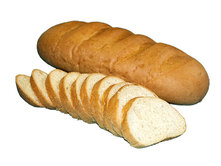 |
| Blynai - pancakes. There is a variety of pancake recipes in Lithuanian cooking, such as pancakes with curd cheese, yeast, apples, zucchini, as well as potato pancakes (Bulviniai blynai). They are often served with sour cream or jam. See also Lietiniai su varške, Mieliniai blynai. | 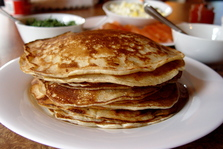 |
| Bulviniai blynai - grated potato pancakes. Made from finely grated potatoes and fried in a pan. Commonly served with a sour cream. Grated potato pancakes with ground meat filling are called Kėdainių blynai. |  |
| Čenakai - a stew of meat, potatoes, carrots and other vegetables. Made by baking in the oven. Served in small clay pots as individual servings. |  |
| Cepelinai - potato zeppelins. Known as THE national dish of Lithuania. Potato zeppelins are large dumplings made from grated potato dough, filled with meat (though cheese or mushroom fillings are also common), and served with rich bacon-sour cream gravy. A common slang name for cepelinai is "cepakai". Also known as didžkukuliai. While cooking cepelinai get a nice T-shirt: Cepelinai T-shirt | 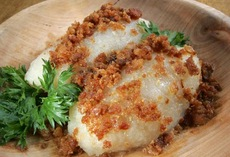 |
| Dešra – Lithuanian sausage. Usually made from pork shoulder, but can be beef, lamb, chicken or veal. Well trimmed meat is often double grind, flavored with sauteed onion, allspice, salt and pepper. Usually served boiled and/or baked fresh but can also be smoked. |  |
| Duona (bread)- see Juoda duona. | |
| Duona su česnaku - garlic bread. It is the dark rye bread deep-fried in oil and tossed with crushed garlic. Nowadays it is also commonly topped with melted cheese and mayonnaise. It is a popular snack to have with beer. | 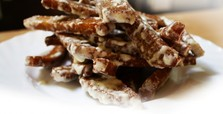 |
| Gira - (Kvas) Gira is a fermented drink made from black rye bread. It is considered a soft drink but contains some alcohol (0.05 -1.5%) due to natural fermentation process. Gira has a unique flavor, contains a lot of vitamin B and is a great drink for a hot day. | 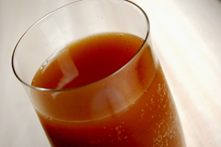 |
| Grietinė - sour cream. It is the most popular condiment in Lithuanian cooking, used both with savory and sweet dishes. | 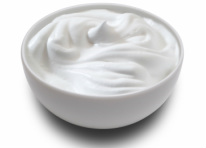 |
| Grybienė - mushroom soup. Usually made with porcini (boletus) mushrooms (see Baravykai), and flavored with bacon bits and sour cream. |  |
| Juoda duona - "black bread". Traditional Lithuanian dense dark rye bread, often flavored with caraway seeds. | 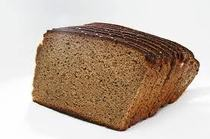 |
| Kaimiški sausainiai – rustic cookies shaped like little bars with ridging on top, traditionally forming the dough through a meat mincer with the cookie attachment. Similar to crispy butter cookies, not too sweet. | 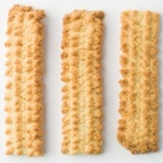 |
| Kastinys - delicate blend of sour cream and butter with herbs, caraway seeds, garlic or other flavors. It is often served as a topping for baked potatoes. Kastinys originated in the region of Samogitia in Western Lithuania. |  |
| Kėdainių blynai - grated potato pancakes with ground meat filling. Also see Bulviniai blynai. |  |
| Kefyras – buttermilk, kefir. The term likely originated from the Middle Eastern kefir, though the connection is unclear. Kefyrasis the key ingredient of cold soup (Šaltibarščiai). It is sometimes served as a drink with fried potatoes (Keptos bulvės). | 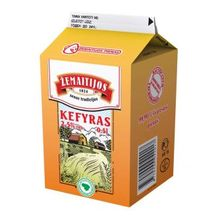 |
| Keptos bulvės - fried potatoes. A common and simple food that is fast to prepare. The potatoes are thinly sliced and fried in a pan. Various toppings (meat, egg, cheese, vegetables) may be added. Often served with a pickle and sometimes with a drink of buttermilk (see Kefyras). | 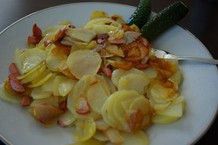 |
| Kiaušinienė - omelette. Often fried with bacon and served with dark rye bread. | 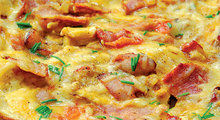 |
| Kibinai - rolled dough meat pies. Originated from the Karaite ethnic minority of the Lithuanian region of Trakai. The best kibinai are thought to be served there. |  |
| Kisielius - a boiled drink flavored with fruits or berries (cranberries being the most popular flavor) and thickened with starch. Served warm or cold, and is a favorite in winter. | 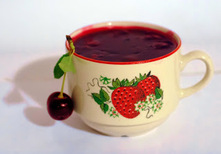 |
| Koldūnai - dumplings. Usually stuffed with meat, but curd cheese, mushroom and other stuffings are popular too. Also called virtiniai. Unique to Lithuania is stuffing with bilberries or blueberries. (see Šaltanosiai). |  |
| Kotletai - fried ground meat patties, commonly served with gravy and mashed potatoes. Translated as cutlets, but they really are more like hamburger texture. | 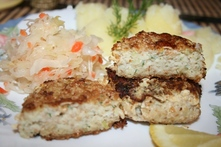 |
| Krupnikas - a traditional sweet alcoholic drink similar to a liqueur, based on grain spirits and clover honey,as well as up to 50 different herbs. It may be served hot, at room temperature or chilled. |  |
| Kūčiukai - a traditional dish served during the traditional Christmas Eve dinner in Lithuania. They are crouton-sized pastries made from plain dough and poppy seeds. Other name for Kūčiukai are Šližikai or Preskučiai. |  |
| Kugelis - sometimes we call it Plokštainis. A dish made of grated potatoes and baked in the oven. It looks somewhat like a potato pie or casserole. Both the dish and the former name are believed to have their roots in Germany. Baltic Value T-shirt for cooking kugelis, have fun: Kugelis T-shirt (Photo by Amber Reunion) | 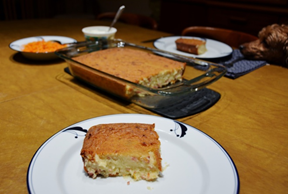 |
| Kumpis - ham. Smoked ham is the most popular variety. | 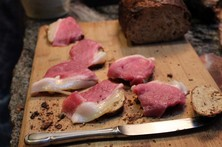 |
| Lašinėčiai – bacon buns. Slightly sweet yeast dough filled with cooked chopped bacon with onion. Very popular. | 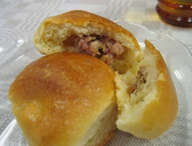 |
| Lašiniai - country bacon or highfat ham. Often used to prepare gravy for potato dishes. | 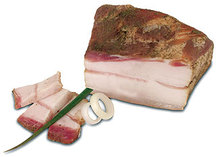 |
| Lietiniai su varške - crepes with curd cheese filling. Often flavored with cinnamon, berries or fruits. Also called Naliesnikai, though this word is of Slavic origin. |  |
| Mieliniai blynai - yeast pancakes. Pancake dough is raised by bakers yeast and fried in a pan as pancakes. Served with sour cream or jam. | 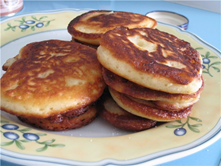 |
| Napoleon Torte – a mille-feuille pastry made of multiple thin layers of wafer filled with a custard and perhaps an occasional jam layer such as apricot. It was introduced during Napoleon's passage through Lithuania in the 19th century. |  |
| Plokštainis - one of Lithuanian favorites, plokštainis is a dish made of grated potatoes and baked in the oven. It looks somewhat like a potato pie or casserole. Originally it was called Kugelis, though Plokštainis is the term more commonly used nowadays. Both the dish and the former name are believed to have their roots in Germany. (Photo by Amber Reunion) | 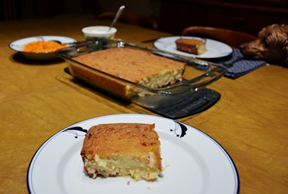 |
| Pyragas – pie or cake. A variety of cakes can be found in Lithuanian cuisine, from sweetened breads, coffee cakes, fruit breads, and tortes. Usually not overly sweet. | 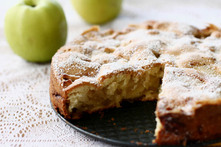 |
| Raudona mišrainė - "red salad". In addition to Balta mišrainė (white salad), it is one of the most popular salads in Lithuanian cooking. Red salad is made of beets (hence the characteristic red color), beans, pickles and dressing (mayonnaise or vinaigrette). |  |
| Rauginti kopūstai - pickled cabbage (sauerkraut). Often served as a crunchy side or stewed with pork ribs (see Troškinti kopūstai). | 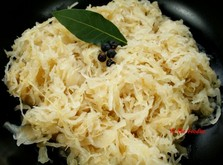 |
| Ruginė duona - see Juoda duona. | |
| Rūgpienis - fermented, sour milk. Similar to yogurt. Also called raugintas pienas. | 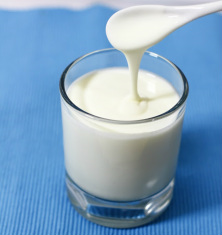 |
| Šakotis - tree cake. Originated from German Baumkuchen. Due to the complexity of its baking process, it is almost never made at home, but rather baked in specialized large or boutique bakeries. Used to be a traditional cake for weddings, though this trend is disappearing. Also called raguolis. |  |
| Šaltanosiai - literally translated as "cold noses", šaltanosiai are dumplings stuffed with bilberries or blueberries. See koldunai, virtiniai. | 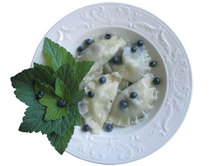 |
| Šaltibarščiai - cold beet soup. Made with buttermilk, cucumber, eggs, dills and boiled grated beets, which give the soup its characteristic pink appearance. Usually eaten in early summer served with boiled potatoes. Sometimes tourists coming to Lithuania call it "pink soup".:) | 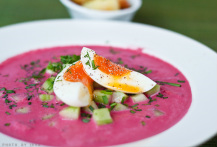 |
| Šaltiena - a dish made from pig parts with high cartilage and collagen content (ears, feet) by boiling them, shredding and letting set in a refrigerator. Usually served cold & dressed with vinegar or mayonnaise. Jellied pigs feet. Also called Košeliena. | 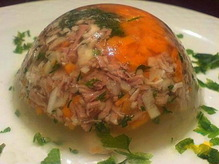 |
| Šašlykai - skewers of grilled meat. The term and the recipe have originated from Georgia (a country in the Caucasus mountains), made its way to Lithuania during the Soviet era and has been popular since. Though traditional Georgian grill uses mutton, the Lithuanian version of šašlykai is usually made of pork. Often served with rice, dark rye bread, green onions, cucumbers and tomato ketchup. | 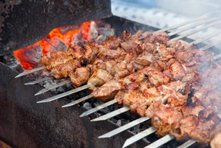 |
| Silkė - herring. Likely the most popular fish in the Lithuanian kitchen, usually consumed pickled or salted. Various herring salads are common as appetizets in festive meals and family gatherings. | 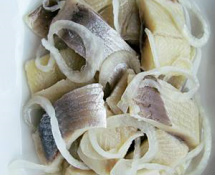 |
| Skilandis - smoked and dried sausage made of ground meat and pork belly. The meat used to be traditionally stuffed into a pig's stomach, though now artificial casings are often used. |  |
| Šližikai - see Kūčiukai. | |
| Spurgos - see Varškės spurgos. | |
| Sumuštiniai - sandwiches. Traditionally, Lithuanian sandwiches are made with dark rye bread and are open-faced. Common toppings include cured meats, sausages, cheese, preserved fish. Sandwiches are regarded as appetizers or snacks, and not the main course. | 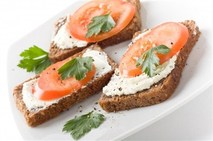 |
| Sūris (baltas sūris) - cheese. Lithuanian cuisine boasts a variety of cheeses, varying from hard cheeses to soft ones, as well as curd cheeses, smoked cheeses, and dessert cheeses. Especially farmers cheese. | 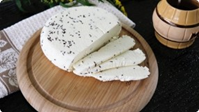 |
| Švilpikai - literally translated as "whistlers", švilpikai are fried or oven-baked potato dough dumplings, often served with rich boletus mushroom or bacon gravy. | 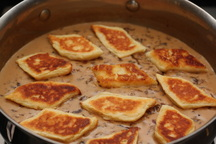 |
| Tinginys - literally translated as "lazy man", tinginys is a refrigerated dessert made from broken hard cookies, condensed milk, cocoa and butter. | 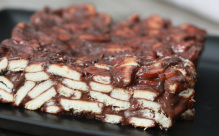 |
| Troškinti kopūstai - stewed pickled cabbage (sauerkraut). Usually boiled together with pork ribs, garnished with bacon bits and served with boiled potatoes. | 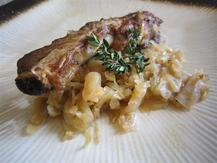 |
| Varškė - curd cheese. One of the most popular dairy products in the Lithuanian kitchen, which boast a large variety of recipes using curd cheese - see Lietiniai su varške, Varškėčiai, Varškės apkepas, Varškės spurgos. | 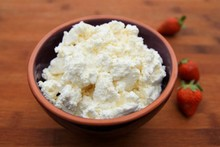 |
| Varškėčiai - curd cheese patties, either boiled or fried. | 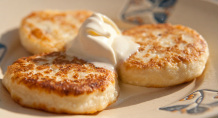 |
Varškės apkepas - curd cheese cake. Though it may be reminiscent of the American cheese cake, the curd cheese cake is softer, not sweet and is often served for breakfast or supper. It is not regarded as a dessert. |  |
Varškės spurgos - curd cheese doughnuts. As the name implies, curd cheese (Varškė) is the main ingredient in the dough of these pastries. Curd cheese doughnuts are usually shaped as small deepfried balls. |  |
Vėdarai - pig intestines stuffed with either potato filling (Bulviniai vėdarai) or blood and barley grain filling (Kraujiniai vėdarai). Served fried. | 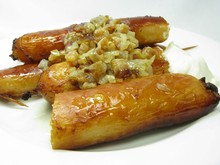 |
Voveruškos – chanterelles. Used fresh, dried, salted, ground into flour, frozen. Best when cooked. A young chanterelle has much thiamine (vitamin B). Also called voveraitės. | 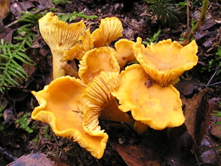 |
Žagarėliai - literally translated as "twigs", žagar÷liai are crispy deepfried pastries. They are commonly shaped by rolling the dough flat and cutting it into elongated diamond shapes. The shapes are then slit in the middle, and one corner is threaded through the slit, which gives žagarėliai their characteristic look. Also called krustai. | 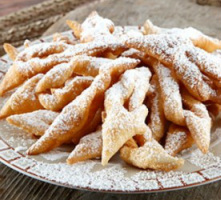 |
Žemaičių blynai - Samogitian pancakes. Originated in the Western Lithuanian region of Samogitia, these fried patties are made from mashed potato dough and filled with ground meat. Usually served with melted butter and sour cream. | 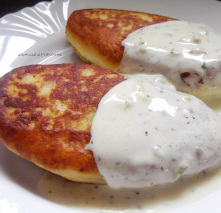 |
Žemaičių košė - Samogitian porridge. A mashed potato dish with fried bacon bits and onion topping served with kefir or buttermilk. Some also like to spoon over some kastinys. | 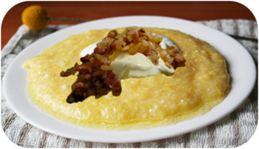 |
